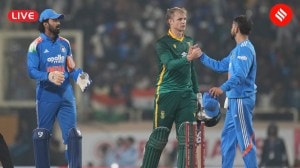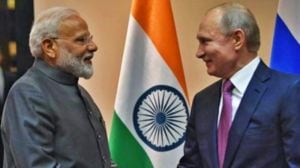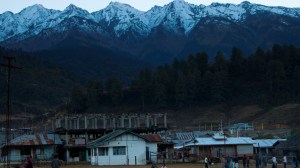Early Strokes
Appreciating art is often a matter of aesthetics,of combining instinct with acquired taste.
Appreciating art is often a matter of aesthetics,of combining instinct with acquired taste.
Appreciating art is often a matter of aesthetics,of combining instinct with acquired taste. Nadia Samdani,CEO of the Dhaka-based Samdani Art Foundation,shaped her instincts under her father Khalilur Rahman Choudhury,a prominent Bangladeshi industrialist. Born in Britain,where the family lived for a while,conversations at meal times and social gatherings would often revolve around the new show at the local art gallery,or on the merits of artists from across the border,in India. There was a sizeable art collection at home,and family favourites ranged from the Tagores to Pablo Picasso. At 22,when she started her own collection,Nadia already had a finger on the pulse of the contemporary global art scene.
Eight years later,as she organised the first Dhaka Art Summit (DAS) recently held in Bangladesh,it was this experience that Nadia and her husband Rajeeb,also an art aficionado,relied upon. Formatted on the lines of the very successful India Art Summit,the four-day event,held in Dhaka in collaboration with the Bangladesh National Museum and Bangladesh Shilpakala Academy (National Academy of Fine and Performing Arts),differed only in focus. It pivoted on local art,with 19 galleries and 249 Bangladeshi artists participating in the fair. Amin Jaffer,international director of Asian Art at auction house Christies and Maithili Parekh,director,business development,India at Sotheby’s,put in an appearance,as did representatives from Londons Tate Museum and Indian galleries and artists. It’s an interesting time to look at art in south Asia,particularly after India’s flourish in the last two decades. Bangladesh has a very unique artistic milieu,but not much is known about it in the hue and cry over its poverty and over population. The time’s ripe to look at the market and assess its potential,just when the opportunities are beginning to roll in,” says Nadia.
The time,indeed,seems right to focus on an event of this stature in the country. In recent years,Bangladesh has made significant inroads into the international art scene. The biennial Chobi Mela,begun by photographer Dr Shahidul Alam,is one of Asia’s largest photography festivals. While Shahabuddin and Zainul Abedin are familiar names at international auctions,Mohammad Wahiduzzaman and Tayba Begum Lipi are gaining popularity beyond the subcontinent. Berlin-based Bangladeshi artist Wakilur Rahman is on an upward curve in the art mart,Mahbubur Rahman’s Britto Arts Trust is a contemporary art hub,involved in experimentation in visual and performing arts,somewhat like the Khoj Artists’ Studio in India. Bangladesh’s participation at the Venice Biennale last year,one of the most important contemporary art festivals,made possible because of Britto’s initiative,generated visibility and a curiosity about a market still relatively untapped. Art in Bangladesh is largely unorganised. Galleries don’t represent artists,they represent themselves. There is little corporate sponsorship. Artists are left to their devices to put forward their art,either on their own or with help from cooperatives. Once these things are taken care of,the art market will function better, says Nadia.
At the fair,participation was free for the artists and the audience,to encourage more footfalls. Talks,seminars and art walks were organised to familiarise the local audience and the visiting galleries and connoisseurs with the country’s art scene. It was a fabulous philanthropic gesture from the Samdanis. They could have possibly spent that money on adding another Anish Kapoor to their collection,but to give it back to art that is for public consumption is an emotional,and rather difficult,decision. The Dhaka Art Summit was a good incentive for their artists,particularly the emerging ones,in terms of impetus and exposure, says Bhavna Kakar,director of Indian gallery Latitude 28,who attended the DAS.
Emerging artists have always been the Samdanis’ weakness. I have seen tremendous potential in them in the last few days (during the DAS),which makes me proud. We have been thinking of doing something for the Bangladeshi art scene for the past three years. We finally started the (Samdani Art) foundation last year with the intention of promoting Bangladeshi art and artists internationally. We have to keep supporting the young and emerging artists of Bangladesh, says Rajeeb,38,managing director of the Golden Harvest group,a diversified group of companies involved in food processing,commodity trading,real estate,logistics,IT and aviation. In December last year,the Samdani Art Foundation invited representatives of Tate Modern Museum,UK’s international art division to Dhaka,following their announcement of a new south Asian wing to the museum in London. They also helped host a show by emerging local artists at the same time to give the visitors a better idea of the kind of work coming out of the country.
Their collection at home,an enviable mix of paintings,installations and sculptures,has works by both the masters and upcoming artists. Among the masters,the Tagores are a favourite,like the 2010 Rabindranath Tagore,which Rajeeb bought at a Sotheby’s auction for 91,250,and several works by Abanindranath and Gaganendranath Tagore. There’s a large selection from the Bengal school of art,including Jamini Roy and Mukul Dey; works by young Indian artist Saravanan Parasuraman and Pakistani veteran Rashid Rana. Among international artists,Takashi Murakami,Andy Warhol,Damien Hirst,Yves Klein,Dali,Picasso and Rembrandt find pride of place in their modest collection of 2,000 artworks. Much of our choice is dictated by shock or surprise,whatever the initial response the works evoke, says Nadia.
The inaugural DAS has drawn favourable,if cautious reactions,and plans are afoot for the next one. While it took them four months to plan out this year’s event,the Samdanis hope to organise the event only in the latter half of 2013,close to the India Art Summit,as a possible cultural trail in the subcontinent,much like the Sharjah Biennale and Art Dubai in the Middle East. But the business aspect of it will only be chalked out later,once they go through the fine print of this edition. It does not make much sense to have too many events crammed together without being adequately prepared. We need more sponsorship,better advertising and a more informed audience. It’s a gradual process. We have just made a start, says Nadia.


- 01
- 02
- 03
- 04
- 05





























